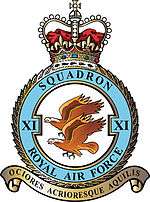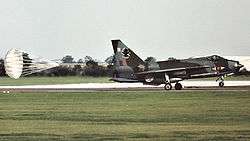No. 11 Squadron RAF
| No. 11 Squadron RAF | |
|---|---|
 | |
| Active |
14 February 1915 -1919 1923 – February 1948 1949–1957 1956–1966 1967–2005 29 March 2007 – |
| Role | Air Defence, Air Interdiction, Close Air Support, Ground Attack |
| Garrison/HQ | RAF Coningsby |
| Motto(s) |
Latin: Ociores acrioresque aquilis ("Swifter and keener than eagles") |
| Equipment | Typhoon FGR4 |
| Battle honours | Western Front 1915–1918, Loos, Somme 1916, Arras, Cambrai 1917, Somme 1918, Amiens, Hindenburg Line, North-West Frontier 1930–1931, North-West Frontier 1935–1939, East Africa 1940, Egypt and Libya 1940–1942, Greece 1941, Syria 1941, Ceylon April 1942, Arakan 1943–1944, North Burma 1943–1944, Manipur 1944, Burma 1944–1945. |
| Insignia | |
| Squadron Badge heraldry | Two eagles volant in pale |
| Squadron roundel |
 |
No. 11 or XI Squadron is a Royal Air Force fighter squadron. The squadron operated the Tornado F3 until 2005 when it was disbanded. It was reactivated in 2006 to operate the Typhoon F2, receiving its first aircraft (serial number ZJ931) on 9 October 2006.[1]
History
World War 1
No. 11 Squadron of the Royal Flying Corps was formed at Netheravon in Wiltshire on 14 February 1915 for "fighting duties", receiving two seat pusher Vickers Gunbus fighters in June, and deploying to France on 25 July 1915.[2] Since all previous squadrons (Royal Flying Corps or other nations) were reconnaissance or army co-operation units, 11 can make a claim to be the oldest dedicated fighter squadron in the world. The squadron has had the honour of having two Victoria Cross winners serve in the unit.
The squadron's Gunbusses were soon pressed into service, with Second Lieutenant G. S. M. Insall being awarded a Victoria Cross for an action on 7 November 1915 in which he forced down and destroyed a German Aviatik observation aircraft.[3] The Gunbus was already obsolete however, and was replaced by Royal Aircraft Factory F.E.2 fighters of similar layout, but higher performance, in June 1916. These in turn were replaced by Bristol Fighters in August 1917, these being used both for offensive patrols over German-held territory and for ground attack for the remainder of the war. The Squadron was disbanded at the end of 1919.[4]
No. 11 Squadron numbered 19 flying aces in its ranks during the war. Among them were Victoria Cross winner Lionel Rees, as well as Andrew Edward McKeever, future Air Commodore John Stanley Chick, Eugene Coler, Albert Ball VC, Frederick Libby, Ronald Maudit, John Quested, Herbert Sellars, Donald Beard, Stephen Price, Hugh Hay, and Encyclopedia of Modern Royal Air Force SquadronsThomas Frederick Stephenson.[5]
The twin Eagles on the Squadron's crest, awarded in May 1937, represent the two-seated fighters operated in the First World War.[6]
Between the Wars
The Squadron reformed at RAF Andover in January 1923 as a day bomber squadron equipped with Airco DH.9As, soon moving to RAF Bircham Newton in Norfolk. In April 1924, these were replaced by the Fairey Fawn despite the fact that they offered little improvement in performance over the DH.9A, moving with them to RAF Netheravon in May that year. The unpopular Fawns were replaced by Hawker Horsleys in November 1926, in use until December 1928, when the squadron handed the Horsleys to 100 Squadron and was posted to Risalpur in India (now in Pakistan), flying Westland Wapitis in Army co-operation and carrying out punitive air raids against rebelling tribal forces.[4][7] It replaced its Wapitis with Hawker Harts in February 1932, operations continuing as before.[4] On 31 May 1935, the 1935 Balochistan earthquake devastated the city of Quetta and the surrounding area. No. 11 Squadron, along with other RAF squadrons in the region, were used to aid the relief effort following the disaster.[8] The squadron received Blenheim I monoplane bombers in July 1939, moving to Singapore the next month, just before the outbreak of World War II in Europe.[4]
World War II

In April 1940 the squadron moved to India, and was briefly based at Karachi before was ordered to transfer to Aden due to the increasing likelihood of war with Italy.[9][10] The first of the squadron's Blenheims reached Aden on 19 June 1940, nine days after Italy declared war on Britain,[11] and flew its first combat mission of the war on 19 June.[12] The squadron was heavily engaged in the early months of the Eastern Africa campaign, attacking Italian targets in Italian East Africa.[9][13]
In early 1941 the squadron was sent to reinforce the Royal Air Force squadrons in Greece, fighting in the Greek Campaign first against the Italians and then the Germans. The few surviving aircraft and crews were evacuated to Crete and then on to Palestine. After reforming, the squadron served in the Syrian Campaign against the Vichy French and later took part in the Anglo-Soviet operation to secure the Persian oilfields for the Allies. After returning to Egypt the squadron took part in Operation Crusader.
Redeployed to Colombo, Ceylon in early 1942, the squadron was involved in attacks on Japanese shipping. During 1943, the Squadron re-equipped with Hurricanes and moved to Burma in the ground attack role, supporting the Fourteenth Army.
By January 1943, Royal Australian Air Force (RAAF) personnel, or Australians serving in the RAF, made up almost 90% of the aircrews in the squadron (even though it was not officially an RAAF "Article XV squadron"). At the time, the Australian personnel included the CO, W/Cdr Harley Stumm.[14]
11 Squadron was one of the few RAF squadrons to fight against Italian, German, Vichy French and Japanese forces.[15]
Since 1945



The Squadron formed part of the occupation forces in Japan from August 1945 to February 1948, when it disbanded. Reforming in Germany during October 1949, they flew Mosquitos, Vampires and Venoms. The Squadron again disbanded in 1957, but reformed in January 1959 with Meteor night fighters. Javelins replaced the Meteors three years later and the Squadron was based at RAF Geilenkirchen West Germany equipped with this type until another disbandment in 1966.[15]
Reforming in early 1967, No. 11 Squadron spent the next 21 years flying Lightnings, until May 1988.[15] By that time it was one of the last two squadrons equipped with this aircraft and was based at RAF Binbrook in Lincolnshire.[16]
The squadron operated the twin seat Panavia Tornado F3 from RAF Leeming between August 1988 and October 2005.
In February 2003 it was announced that some of No. 11 Squadron's Tornado F3s had been modified to carry the ALARM missile (as EF3s) to widen their capabilities to include suppression of enemy air defences (SEAD). The logic of this is clear, as Tornado GR4s are required to carry large offensive payloads while in recent conflicts the requirement for air superiority fighters has been limited.
Following the publication of the Future Capabilities study on 21 July 2004, XI(F) squadron disbanded in October 2005. The RAF announced that 11 Squadron would be the second front line squadron to re-equip with the Typhoon but would now be based at RAF Coningsby. The Squadron stood up at Coningsby on 29 March 2007, dropping the (F) designation in recognition of its new tasking as the Royal Air Force's lead Typhoon multi-role squadron.
In March 2011, 11 Sqn (assisted by some 29(R) squadron personnel and additional aircraft supplied by 29(R) and 3(F) Sqns) deployed to Gioia Del Colle, Bari, Italy, to help police the no-fly zone imposed by Resolution 1973 over Libya as part of Operation Ellamy.[17]
In 2013 the squadron deployed to the Mediterranean again, this time RAF Akrotiri in Cyprus, as part of 121 EAW providing air defence of Cyprus under the auspices of Operation Luminous.[18]
XI(F) Squadron resumed the use of its '(F)' Fighter status during its centenary year, with celebrations taking place on the 7th and 8th of May 2015 in the form of a formal dinner with the Squadron Association, and a parade complete with flypast.[19]
See also
References
- ↑ "100th Typhoon arrives at RAF Coningsby". www.raf.mod.uk. Royal Air Force. 2006-10-09. Retrieved 2006-10-26.
- ↑ Ashworth 1989, pp. 51–52
- ↑ Guttman 2009, pp. 19–20.
- 1 2 3 4 Ashworth 1989, p.52.
- ↑ "11 Squadron". theaerodrome.com. Retrieved 24 September 2016.
- ↑ Ashworth 1989, p.51.
- ↑ Lewis 1959, p.17.
- ↑ Delve 1985, p. 50.
- 1 2 Moyes 1964, p. 65.
- ↑ Shores 1996, pp. 13–14.
- ↑ Shores 1996, pp. 17, 22.
- ↑ Shores 1996, p. 24.
- ↑ Shores 1996, pp. 27, 31, 40, 54–57, 59.
- ↑ George Odgers, 1968 (orig. 1957), Australia in the War of 1939–1945. Series 3 – Air: Volume II – Air War Against Japan, 1943–1945, Canberra, Australian War Memorial, p. 256.
- 1 2 3 "11 Squadron Page". RAF Website. Retrieved 24 September 2016.
- ↑ "The last last Lightning show... [sic]". Air-Scene UK. Retrieved 24 September 2016.
- ↑ http://www.onetooneonline.co.uk/PDFs/onetoone_issue_4.pdf
- ↑ http://www.onetooneonline.co.uk/xi-sqn-update-6/
- ↑ http://www.onetooneonline.co.uk/xi-sqn-centenary-celebrations/
Sources of information
- Ashworth, Chris. Encyclopedia of Modern Royal Air Force Squadrons. Wellingborough, UK:PSL, 1989. ISBN 1-85260-013-6.
- Delve, Ken. The Winged Bomb: History of 39 Squadron RAF. Earl Shilton, Leicester, UK: Midland Counties Publications, 1985. ISBN 0-904597-56-3.
- Lewis, Peter. Squadron Histories: R.F.C, R.N.A.S and R.A.F., 1912–59. London: Putnam, 1959.
- Guttman, Jon, et al. Pusher Aces of World War 1 Osprey Pub Co, 2009. ISBN 1-84603-417-5, ISBN 978-1-84603-417-6.
- Moyes, Philip. Bomber Squadrons of the R.A.F. And Their Aircraft. London: Macdonald, 1964.
- Shores, Chris. Dust Clouds in the Middle East: The Air War in East Africa, Iraq, Syria, Iran and Madagascar, 1940–1942. London:Grub Street, 1996. ISBN 1-898697-37-X.
- Shores, Chris. Giovanni Massimello and Russell Guest. A History of the Mediterranean Air War 1940–1945: Volume One: North Africa June 1940–January 1942. London: Grub Street, 2012. ISBN 978-1-908117-07-6.
- Warner, Graham. The Bristol Blenheim: A complete history 2nd Edition. Crecy Publishing, 2005. ISBN 0-85979-101-7.
External links
| Wikimedia Commons has media related to No. 11 Squadron RAF. |